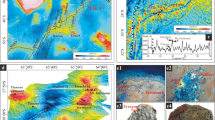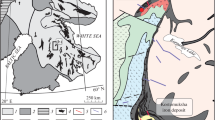Abstract
The sulfur isotopic composition of sulfides and barite from hydrothermal deposits at the Valu Fa Ridge back-arc spreading center in the southern Lau Basin has been investigated. Sulfide samples from the White Church area at the northern Valu Fa Ridge have δ34S values averaging +3.8‰ (n= 10) for bulk sphalerite-chalcopyrite mineralization and +4.8‰ for pyrite (n= 10). Barite associated with the massive sulfides exhibits an average of +20.7‰ (n= 10). Massive sulfides from the active Vai Lili hydrothermal field at the central Valu Fa Ridge have much higher δ34S ratios averaging +8.0‰ for bulk sphalerite-chalcopyrite mineralization (n= 5), +9.3‰ for pyrite samples (n= 5), and +8.0‰ and +10.9‰ for a chalcopyrite and a sphalerite separate, respectively. The isotopic composition of barite from the Vai Lili field is similar to that of barite from the White Church area and averages +21.0‰ (n= 8). Sulfide and barite samples from the Hine Hina area at the southern Valu Fa Ridge have δ34S values that are considerably lighter than those observed for samples from the other areas and average −4.9‰ for pyrite (n= 9), −4.0 and −5.7‰ for two samples of sphalerite-chalcopyrite intergrowth, and −3.4‰ for a single chalcopyrite separate. The total spread in the isotopic composition of sulfides from Vai Lili and Hine Hina is more than 20‰ over a distance of less than 30 km. The δ34S values of sulfides at Hine Hina are the lowest values so far reported for volcanic-hosted polymetallic massive sulfides from the modern seafloor. Barite from the Hine Hina field also has unusually light sulfur with δ34S values of +16.1 to +16.7‰ (n= 5). Isotopic compositions of the sulfides at Hine Hina indicate a dramatic decrease in δ34S from ordinary magmatic values and, in the absence of biogenic sulfur and/or boiling, imply a unique 34S-depleted source of probable magmatic origin. Sulfide-barite mineralization in the Hine Hina area is associated with a distinctive alteration assemblage consisting of cristobalite, pyrophyllite, kaolinite, opal-CT, talc, pyrite, native sulfur, and alunite. Similar styles of alteration are typically known from high-sulfidation epithermal systems on land. Alunite-bearing, advanced argillic alteration in the Hine Hina field confirms the role of acidic, volatile-rich fluids, and a δ34S value of +10.4‰ for the sulfur in the alunite is consistent with established kinetic isotope effects which accompany the disproportionation of magmatic SO2 into H2S and H2SO4. The Hine Hina field occurs near the propagating tip of the Valu Fa back-arc spreading center (i.e., dominated by dike injections and seafloor eruptions) and therefore may have experienced the largest contribution of magmatic volatiles of the three fields. The sulfur isotopic ratios of the hydrothermal precipitates and the presence of a distinctive epithermal-like argillic alteration in the Hine Hina field suggest a direct contribution of magmatic vapor to the hydrothermal system and support the concept that magmatic volatiles may be an important component of some volcanogenic massive sulfide-forming hydrothermal systems.
Similar content being viewed by others
Author information
Authors and Affiliations
Additional information
Received: 16 January 1997 / Accepted: 28 October 1997
Rights and permissions
About this article
Cite this article
Herzig, P., Hannington, M. & Arribas Jr., A. Sulfur isotopic composition of hydrothermal precipitates from the Lau back-arc: implications for magmatic contributions to seafloor hydrothermal systems. Mineral. Deposita 33, 226–237 (1998). https://doi.org/10.1007/s001260050143
Issue Date:
DOI: https://doi.org/10.1007/s001260050143




